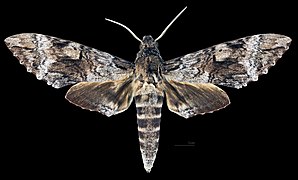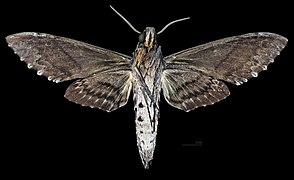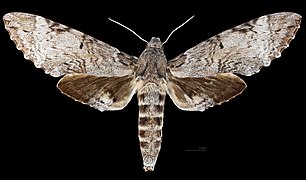Pseudosphinx tetrio
| Pseudosphinx tetrio | ||||||||||||
|---|---|---|---|---|---|---|---|---|---|---|---|---|

Pseudosphinx tetrio |
||||||||||||
| Systematics | ||||||||||||
|
||||||||||||
| Scientific name of the genus | ||||||||||||
| Pseudosphinx | ||||||||||||
| Burmeister , 1855 | ||||||||||||
| Scientific name of the species | ||||||||||||
| Pseudosphinx tetrio | ||||||||||||
| ( Linnaeus , 1771) |
Pseudosphinx tetrio is the only butterfly species of the genus Pseudosphinx from the family of hawkers (Sphingidae). The thus monotypical genus is closely related to the genera Erinnyis and Isognathus .
The species, which is otherwise widespread in tropical and subtropical America, is down-to-earth in Florida only because its development time coincides with the seasonal relocation of many people living there. In the south of Florida, the species is dependent on the red frangipani ( Plumeria rubra ), which is only used as an ornamental plant, as the only caterpillar food. The move of the winter guests in Florida at the beginning of the summer months coincides exactly with the time when the caterpillars develop on the plants. In autumn, when Florida's seasonal residents return, the caterpillars have pupated and the plants drop their leaves depending on the season, so that the considerable amount of leaf damage on the plants usually goes unnoticed. The species thus escapes control by humans, which, due to the strong dependence on this ornamental plant, would lead to a strong decimation in this region.
features
Characteristics of the moth
The moths have a fore wing length of 58 to 78 millimeters and with a wingspan of up to 170 millimeters are among the largest butterflies on the American continent . Their size, the gray-white fore and hind wings and the equally colored body clearly distinguish the species from the other flocks. The species looks similar to some species of the genus Erinnyis , but these are much smaller and have orange or yellow hind wings.
Males and females differ in their shape ( sexual dichroism ). The males have forewings with a dark base color and are clearly patterned. The basic color of the females is significantly lighter and their pattern is less pronounced. The females also tend to be slightly larger than the males. The pattern is relatively variable in both sexes, in particular the contrast of the colors is quite different in the females.
Characteristics of the caterpillars
Even in the first stage, the caterpillars have a noticeable color. Their heads are bright reddish and they have a series of bright yellow stripes on a black background. They keep this color during their development. In all stages the anal horn is thread-shaped, it is wildly moved around when it is disturbed. The color of the caterpillars makes them unmistakable.
Characteristics of the dolls
Immediately after the last moult, the pupa is bright lemon yellow. After a few hours it will begin to darken to a shiny mahogany brown. The doll is very stocky and has a very broad cremaster with a single, sharp point. The trunk sheath is completely fused with the body, the wing sheaths are highlighted with easily recognizable black lines.
Occurrence
The species is particularly widespread in tropical and subtropical America and rarely occurs in North America. The natural northern limit of distribution includes the Antilles and Bermuda . The species is also widespread in the south of Florida, north to Palm Beach and Sarasota , especially in the temperature-favored coastal area, due to the cultivation of its food plants in gardens . There is also evidence from Texas and the lower Rio Grande Valley , which are believed to be permanent populations . Odds have been found from Tucson, Arizona, Mississippi, Louisiana, Arkansas and even from New Jersey and Connecticut.
In its tropical distribution, the species colonizes the xerophytic habitats of its food plants. This limits the range of the species in North America, especially in humid Florida.
Way of life
The adults are attracted by artificial light sources. They are migrant butterflies and can fly over great distances.
Food plants of the caterpillars
The caterpillars apparently feed almost exclusively on Plumeria species. There is evidence of gold trumpet ( Allamanda cathartica ) from Puerto Rico, but this plant is only reluctantly accepted in breeding. Whether they also eat other dog poison plants (Apocynaceae) is controversial and still unclear.

development
The females lay their eggs in groups of 30 to 100 on the top and bottom of the food plants. All caterpillars hatch from a clutch within three days. These feed on the food plants in groups. Before they eat a leaf, they first gnaw a hole in the stem from which white sap emerges. This means that they take in less of this juice when they eat the leaf. Unlike most other swarming species, some caterpillars of the species do not go through five, but six caterpillar stages. Depending on this, their development is completed after 24 to 30 days. Their striking coloring, combined with the sociable way of life and the toxicity of the food plants, suggests that the animals warn their predators of their toxicity. However, it is not yet known whether this is actually the case or whether it is just a matter of mimicry . Whether the warning colors are successful in protecting against enemies has also not yet been investigated. Pupation takes place on the ground in a cocoon , which consists of plant parts and the like, which are connected to one another by loose silk threads. The doll is very active when it is disturbed.
supporting documents
Individual evidence
- ↑ a b c d e f g h i j James P. Tuttle: The Hawkmoths of North America, A Natural History Study of the Sphingidae of the United States and Canada. The Wedge Entomological Research Foundation, Washington, DC 2007, ISBN 978-0-9796633-0-7 .
literature
- James P. Tuttle: The Hawkmoths of North America, A Natural History Study of the Sphingidae of the United States and Canada. The Wedge Entomological Research Foundation, Washington, DC 2007, ISBN 978-0-9796633-0-7 .





